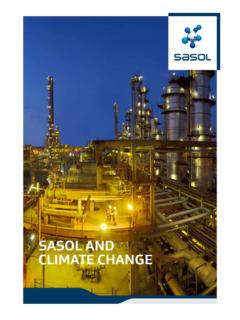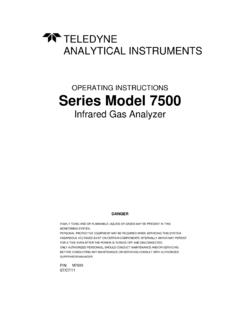Transcription of Volcanic Gases and Aerosols Guidelines - IVHHN.ORG
1 IVHHN Gas Guidelines 1 Volcanic Gases and Aerosols Guidelines The following pages contain information relating to the health hazards of Gases and Aerosols typically emitted during Volcanic activity. Each section outlines the properties of the emission; its impacts on health; international Guidelines for concentrations; and examples of concentrations and effects in Volcanic contexts, including casualties. Before looking at the emissions data, we recommend that you read the general introduction to Volcanic Gases and Aerosols first. A glossary to some of the terms used in the explanations and Guidelines is also provided at the end of this document. Introduction An introduction to the aims and purpose of the Gas and aerosol Guidelines is given here, as well as further information on international guideline levels and the units used in the website.
2 A brief review of safety procedures currently implemented by volcanologists and volcano observatories is also provided. General Introduction Gas and aerosol hazards are associated with all Volcanic activity, from diffuse soil gas emissions to plinian eruptions. The Volcanic emissions of most concern are SO2, HF, sulphate (SO42-), CO2, HCl and H2S, although, there are other Volcanic volatile species that may have human health implications, including mercury and other metals. Since 1900, there have been at least 62 serious Volcanic -gas related incidents. Of these, the gas-outburst at Lake Nyos in 1986 was the most disastrous, causing 1746 deaths, >845 injuries and the evacuation of 4430 people. Other Volcanic -gas related incidents have been responsible for more than 280 deaths and 1120 injuries, and contributed to the evacuation or ill health of >53,700 people (Witham, in review).
3 Most of these casualties (149 deaths and 1000 injuries) were caused by a CO2 release during the eruption of Dieng, Indonesia in 1979. Numerous other incidents of short-term respiratory distress associated with Volcanic emissions probably go unreported. Little detailed work has been done on the relationship between Volcanic air pollution and health. A review of the medical literature (Hansell and Oppenheimer, in preparation) revealed only 25 primary epidemiological studies of varying quality considering the effects of Volcanic Gases . Individuals requiring more detailed information on epidemiological studies of the human health effects of the substances reviewed are referred to the TOXNET database ( ). Aim Various organisations conduct volcano research. These include volcano observatories, governmental organisations, national institutes and universities.
4 Information on the hazards of Volcanic emissions is relevant to all these bodies, as well as to volcano tourists and the people that live and work near active volcanoes. There is a growing demand, both within the volcanological community and from the other parties that deal with the impacts of Volcanic activity, for a comprehensive database of information on these hazardous emissions. We aim to address this need here and present details of the properties, health impacts, international Guidelines for exposure concentrations, and examples of concentrations and effects in Volcanic contexts, including casualties, for the main hazardous Gases and Aerosols typically emitted during Volcanic activity. IVHHN Gas Guidelines 2 Guidelines The international Guidelines presented for each substance are generally based upon urban and industrial pollution studies so are not necessarily strictly applicable to Volcanic emissions, which have a different overall composition.
5 For example, the Guidelines do not account for any "cocktail" effect that might occur from mixtures of air contaminants. However, as a first order indication of hazardous levels we believe that they are of considerable value for the purposes of planning and emergency response in hazardous areas. Guidelines for both ambient air and occupational exposure are provided. The purpose of the ambient air Guidelines is to provide a basis for protecting public health from the adverse effects of air pollution and for eliminating or reducing to a minimum, those air contaminants that are known to be, or are likely to be, hazardous to human health and well-being (WHO, 1999). These levels are relevant to monitoring air quality in populated areas surrounding volcanoes and to protecting tourists. (Although it is necessary to consider that in many cities anthropogenic pollution levels are already higher than the set Guidelines and that this air pollution alone is considered a major contributor to deaths and illnesses ( WHO, 1999)).
6 The purpose of occupational exposure levels is to protect workers in environments where they might be exposed to higher-than-ambient levels of contaminants, but for shorter work-based exposures. These levels will be of more relevance to those who manage people working in Volcanic areas, such as national parks and volcano observatories, who leave the affected area during their off-duty hours. There is no absolute assurance that levels below the Guidelines will not have damaging effects. In particular, high-risk groups such as children and the ill can react more sensitively. Equally, if the Guidelines are exceeded, it does not mean that in every case, or immediately, damage will occur. There will be an increase risk of adverse effects on health, however. We do not claim to provide an exhaustive review of international Guidelines and it is noted that all Guidelines are subject to change over time.
7 Units Atmospheric gas abundances can be reported as mixing ratios by volume (units of ppm and ppb by volume are convenient for Volcanic plumes and occasionally % for very high abundances, of CO2), or as concentrations (mg m-3 and g m-3). Conversion between the two units is possible if the temperature and pressure at the time of measurement are known. To ensure comparability between data, approximate conversions to mixing ratios have been made in some cases using standard pressure and a temperature of 298 K. In these instances, the original concentrations are also provided in parentheses. All mixing ratios quoted are by volume. Existing Procedures A safe system of work that includes air monitoring is essential at all locations where toxic Gases may be present. The International Association of Volcanology and Chemistry of the Earth's Interior (IAVCEI) Guidelines recommend that field volcanologists carry gas-masks at all times, especially when working in thick fumes or in areas of high gas concentrations (Aramaki et al.)
8 , 1994). Volcanologists and volcano observatories have been contacted to determine what measures, if any, are currently in place to protect against Volcanic Gases and Aerosols . Procedures used by individuals range from minimal (this can be strongly influenced by budget constraints) to attendance on annual training courses and the submission of detailed safety and hazards plans. A wide range of respirators, gas filters and masks are available, but full-face masks are preferred, as these have the benefit of protecting the eyes from acidic Gases and particles. The drawbacks of gas masks are that they are cumbersome, hot and uncomfortable during exertion and when moving over Volcanic terrain. Visibility can also be reduced. Consequently, their use in the field may be initiated only when an individual feels that gas levels are sufficiently high to cause discomfort.
9 This threshold will be different for different individuals and may be above concentrations where damage to health can occur. IVHHN Gas Guidelines 3It appears that most volcano observatories do not have any Guidelines for Volcanic gas and aerosol concentrations and hence no response plans should levels become hazardous. Procedures for reporting concentrations to relevant authorities also do not seem well established in many locations. Attitudes of the authorities in many countries would appear to favour a reactionary approach rather than a mitigatory one, although there are a number of examples of access restrictions being implemented based on scientific reports. Any significant changes to access or procedure based on possible risk would have large implications on tourism in many areas concerned so there is little impetus for change unless an incident occurs.
10 References Aramaki, S., Barberi, F., Casadevall, T. and McNutt, S., 1994. Safety for Volcanologists. Bulletin of Volcanology, 56(2): 151-154. Hansell, A. and Oppenheimer, C., in preparation. Health hazards from Volcanic Gases - a systematic literature review. WHO, 1999. Guidelines for Air Quality, World Health Organisation, Geneva. Witham, C., in review. Volcanic disasters and incidents: a new database. Journal of Volcanology and Geothermal Research. IVHHN Gas Guidelines 4 Sulphur Dioxide (SO2) Sulphur dioxide is one of the most common Gases released in Volcanic eruptions (following water and carbon dioxide) and is of concern on the global scale due to its potential to influence climate. On the local scale SO2 is a hazard to humans in its gaseous form and also because it oxidises to form sulphate aerosol .









